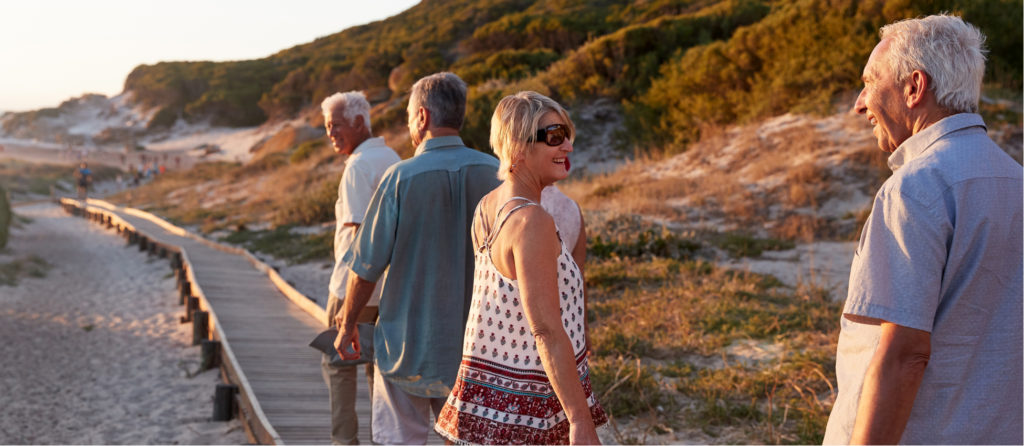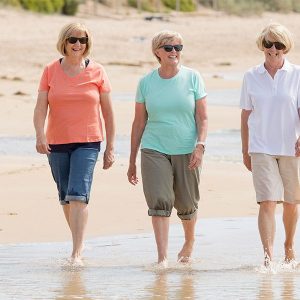Seafarer’s cabin charter holidays are like cruises: you can experience different places without constantly unpacking. The Santorini route around the Cyclades introduced me to Greek islands I’d never heard of, and I wondered how different they’d be.
The picturesque islands all had immaculate white-washed houses with iconic blue doors and shutters, narrow, painted alleys and blue domed churches. However, each was memorable for something we saw, experienced or ate.
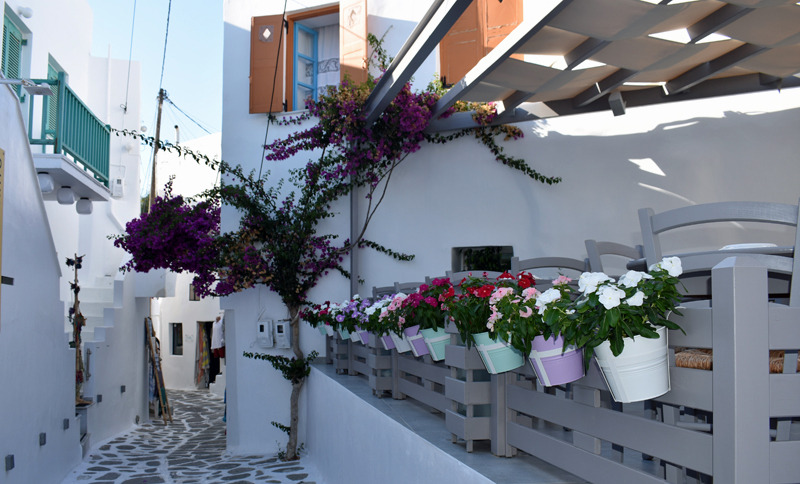
Mykonos – arriving on a late flight, our only experience of Mykonos was a small harbour café where we literally had our first taste of Greece with a late night tiropita (cheese pie) and Alpha beer. The toilets were excellent, something we came to be experts on during the week.
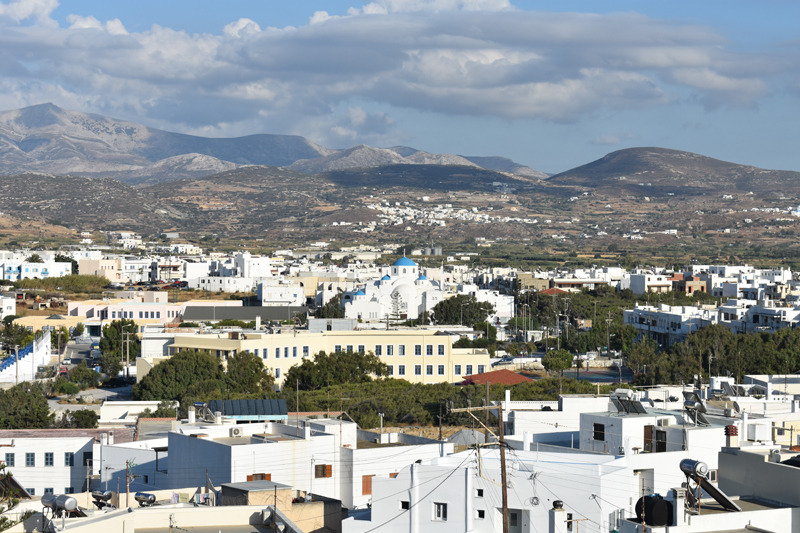 Naxos – after mooring at 4pm, we indulged in happy hour glasses of wine, a €2 bargain, at one of the many harbour front cafes. We walked up through quiet streets to the castle (kastro) and found the Archaeological Museum: unfortunately, both were closed as it was Sunday and late. However, the 1739 Terrasse Café was still open and provided fabulous views and allowed us to recover from the hot climb. Once the sun had cooled, our first dinner at Café Lotto was typically Greek with chicken skewers, Naxos fried potatoes (essentially chips), Greek salad, tzatziki and bread. It was tasty and good value at €8 with a litre of wine at €10.
Naxos – after mooring at 4pm, we indulged in happy hour glasses of wine, a €2 bargain, at one of the many harbour front cafes. We walked up through quiet streets to the castle (kastro) and found the Archaeological Museum: unfortunately, both were closed as it was Sunday and late. However, the 1739 Terrasse Café was still open and provided fabulous views and allowed us to recover from the hot climb. Once the sun had cooled, our first dinner at Café Lotto was typically Greek with chicken skewers, Naxos fried potatoes (essentially chips), Greek salad, tzatziki and bread. It was tasty and good value at €8 with a litre of wine at €10.
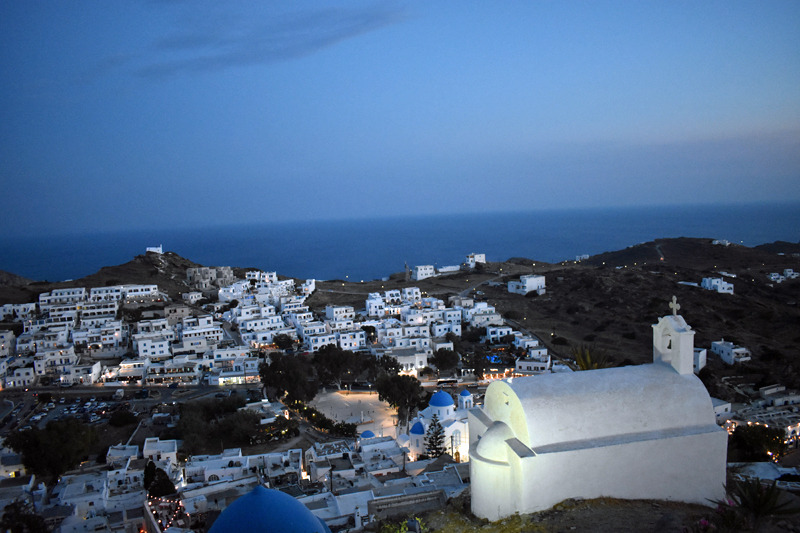 Ios – the hilltop church of Panagia Gremiotissa, which translates as Virgin Mary of the Steep Cliff, is well named. Shallow wide steps quickly became steeper as we walked up narrow streets lined with closed bars and nightclubs (this is a town that only comes to life after 9pm). We stopped for drinks followed by an early dinner at Lord Byron where we were defeated by huge ‘brick size’ pasticcio (Greek pasta bake). The sunset at 8.45pm was slightly cloudy, but the views of Ios and the turquoise Aegean made the huffing and puffing worth it. As we headed back down, bars and clubs were just coming to life: we were ready for bed.
Ios – the hilltop church of Panagia Gremiotissa, which translates as Virgin Mary of the Steep Cliff, is well named. Shallow wide steps quickly became steeper as we walked up narrow streets lined with closed bars and nightclubs (this is a town that only comes to life after 9pm). We stopped for drinks followed by an early dinner at Lord Byron where we were defeated by huge ‘brick size’ pasticcio (Greek pasta bake). The sunset at 8.45pm was slightly cloudy, but the views of Ios and the turquoise Aegean made the huffing and puffing worth it. As we headed back down, bars and clubs were just coming to life: we were ready for bed.
Amorgos – on pre-dinner explorations, signs indicated a Minoa village and Mycenaean Cemetery. But it was still hot and there was no indication of distance, so we settled for al fresco galaktoboureko (Greek custard tart), at the patisserie Honey and Cinnamon.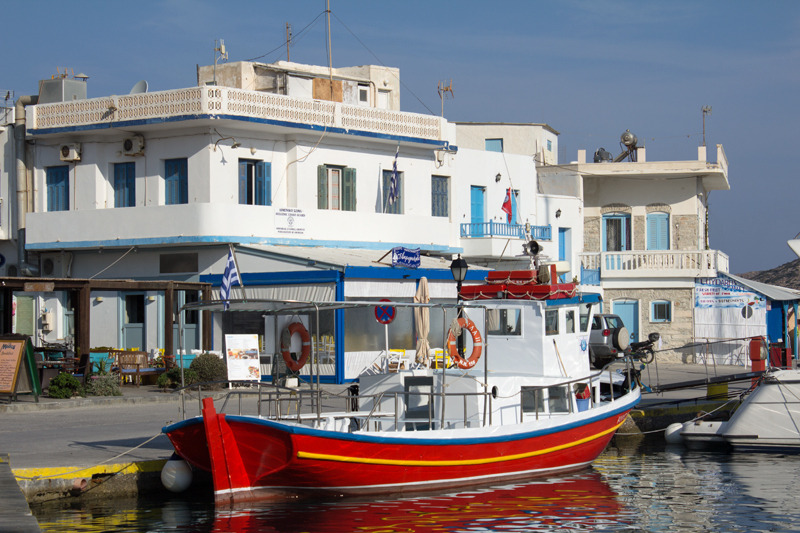 We asked if they sold wine and was told ‘anything is a possibility’ and ended up with large glasses of well chilled white wine. However, the highlight was taking the surprisingly bang on time bus from the harbour to the chora (town): 15 minutes of narrow winding road for €1.80. We found a beautiful unspoilt village, maze of streets and small eateries in tree covered squares and narrow alleys. We ate in Theos, a family run place, where granny took our orders of goat curry. The last bus back was 10pm, so pudding was loukoumades, small sweet doughnut-like balls coated in either honey or chocolate, eaten on the hoof from takeaway style foil containers.
We asked if they sold wine and was told ‘anything is a possibility’ and ended up with large glasses of well chilled white wine. However, the highlight was taking the surprisingly bang on time bus from the harbour to the chora (town): 15 minutes of narrow winding road for €1.80. We found a beautiful unspoilt village, maze of streets and small eateries in tree covered squares and narrow alleys. We ate in Theos, a family run place, where granny took our orders of goat curry. The last bus back was 10pm, so pudding was loukoumades, small sweet doughnut-like balls coated in either honey or chocolate, eaten on the hoof from takeaway style foil containers.
Koufonisia – had a windmill at one end of the small promenade and at the other, a sandy beach with very inviting water. It will be remembered for our first Greek gyros (basically a kebab). Although a take-away from a ‘hole in the wall’ appeared popular judging by the queues, we found stunning white and blue tables on the large terrace at Fos Fanari where a chicken pitta gyros cost €2.20. 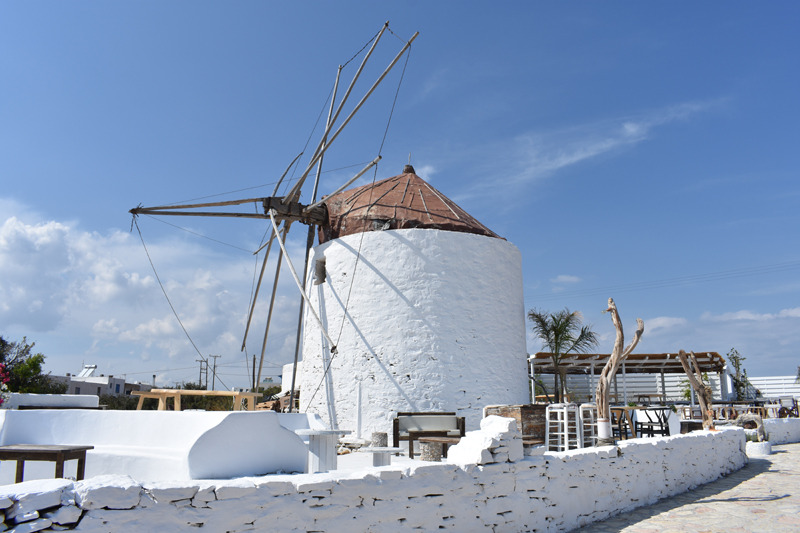 The menu, in an exercise book, was beautifully handwritten in both English and Greek with the prices in pencil. It concluded with, ‘if you would like to leave a comment in the rest of the book, please feel free to do so’.
The menu, in an exercise book, was beautifully handwritten in both English and Greek with the prices in pencil. It concluded with, ‘if you would like to leave a comment in the rest of the book, please feel free to do so’.
Paros – in this delightfully small fishing port we found a tiny church and huge waterfront fish restaurants, whilst the town’s alleys were lined with upmarket boutique shops. We were spoilt for choice at dinner and settled for the Greek/Italian restaurant Meooyelos. As there was a wood oven, it seemed the ideal opportunity for pizza with wonderfully salty anchovies, capers and olives.
Delos – was a bonus whilst sailing back to Mykonos. The uninhabited island is one of the world’s most important archaeological sites but as mooring is not allowed, we took the tender across. After a couple of hours exploring the ruins in the mid-day heat, it was wonderful to jump in the water and cool down before setting off again.
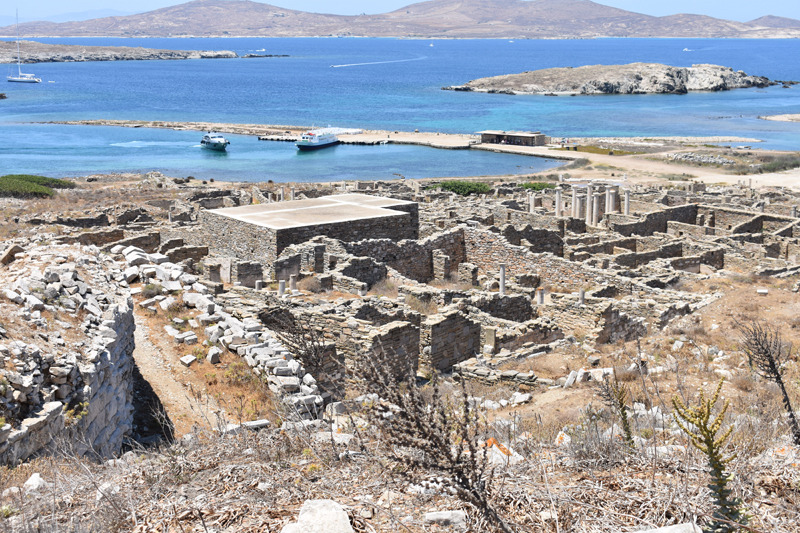 Mykonos – after mooring on our final night back where we’d started, we caught the €2 sea bus to the main town and wandered through Little Venice with its expensive waterfront bars full of beautiful, bronzed young people. Having taken photographs of the iconic 16th century windmills, we wandered through a maze of tourist shops and ate at Kostas, where with our selection of typically Greek cold meze, we drank tsipouro, similar to a fiery Italian grappa. Succulent lamb kleftiko followed, served in the silver foil it had been cooked in.
Mykonos – after mooring on our final night back where we’d started, we caught the €2 sea bus to the main town and wandered through Little Venice with its expensive waterfront bars full of beautiful, bronzed young people. Having taken photographs of the iconic 16th century windmills, we wandered through a maze of tourist shops and ate at Kostas, where with our selection of typically Greek cold meze, we drank tsipouro, similar to a fiery Italian grappa. Succulent lamb kleftiko followed, served in the silver foil it had been cooked in.
So where was Santorini in our route? Unfortunately, finding a mooring on the island is virtually impossible and the ferry times from Ios, didn’t work for us. So, after referring to the sailing bible (Rod Heikell’s book, ‘Greek Waters Pilot’), we all agreed to visit Amorgos instead. This turned out to be the favourite island of all of us, and it was easy to see why Condé Nast Traveller recently suggested it was the Fairest of the Greek Islands.
As well as offering cabin charter, Seafarer are well-known for flotilla holidays and can tailor make holidays to your requirements.
Helen’s cruise was organised by Seafarer who are the UK agent for Variety Cruises, a recommended partner of Silver Travel Advisor.
